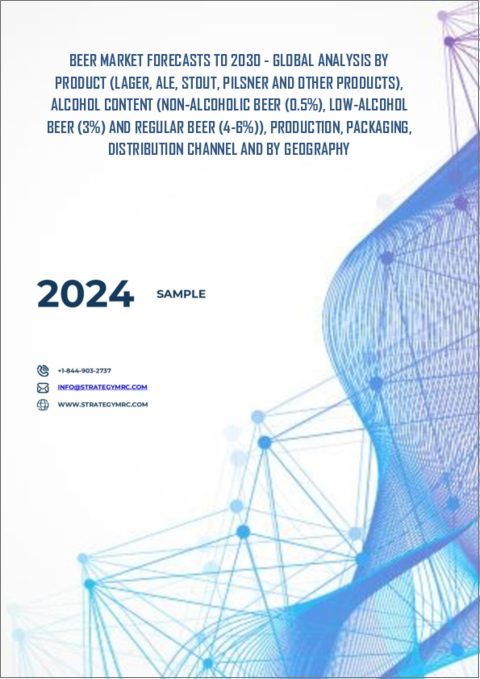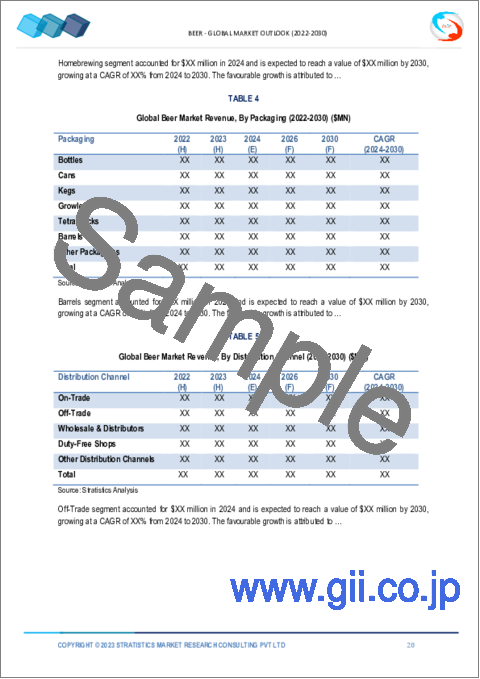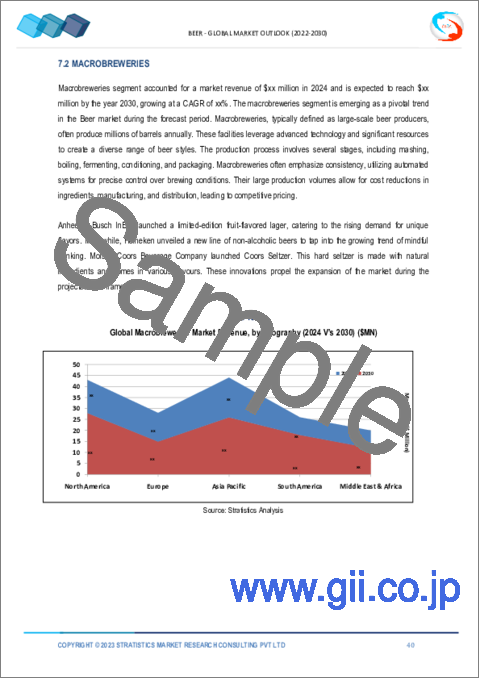|
|
市場調査レポート
商品コード
1438144
ビール市場の2030年までの予測:製品別、アルコール度数別、生産量別、パッケージング別、流通チャネル別、地域別の世界分析Beer Market Forecasts to 2030 - Global Analysis By Product, Alcohol Content (Non-Alcoholic Beer, Low-Alcohol Beer and Regular Beer ), Production, Packaging, Distribution Channel and By Geography |
||||||
カスタマイズ可能
|
|||||||
| ビール市場の2030年までの予測:製品別、アルコール度数別、生産量別、パッケージング別、流通チャネル別、地域別の世界分析 |
|
出版日: 2024年02月02日
発行: Stratistics Market Research Consulting
ページ情報: 英文 200+ Pages
納期: 2~3営業日
|
全表示
- 概要
- 図表
- 目次
Stratistics MRCによると、世界のビール市場は2023年に7,925億1,000万米ドルを占め、予測期間中のCAGRは9.9%で成長し、2030年には1兆5,345億7,000万米ドルに達すると予測されています。
ビールは世界で最も古く、最も広く消費されているアルコール飲料のひとつです。麦芽、水、ホップ、酵母を発酵させて造られるビールは、何千年にも遡る豊かな文化的歴史を誇っています。軽いラガーから力強いスタウトまで、多様なスタイルのビールは、世界中の社交の場や食体験において重要な役割を果たしています。娯楽的な側面だけでなく、ビールはさまざまな伝統や祝祭に欠かせない存在であり、ビールメーカーは進化する嗜好に合わせて常に革新を続けてきました。
国家統計局のデータによると、中国のビール会社の2021年の総利益は27億4,000万米ドルで、2020年から38%増加しました。
国際貿易の拡大
ビール業界の世界化により、多様な醸造技術、原料、地域の風味の交流が促進されています。このような国境を越えた流れは、様々なスタイルのビールの入手可能性と入手しやすさを高め、世界中の消費者に豊富な選択肢を提供するダイナミックな市場を育成します。貿易の拡大はまた、ビールメーカーが新たな市場に参入することを可能にし、消費者にユニークで文化的な影響を受けたビール体験を紹介します。国際貿易の相互作用は、ビール愛好家の選択肢を広げるだけでなく、相互に結びついた世界経済における業界の成長と回復力にも貢献しています。
健康への懸念
ビール消費に伴う健康上の懸念には、肝臓病、心血管障害、肥満などのアルコール関連問題のリスクが含まれます。こうした健康リスクに対する意識の高まりから、消費者の中にはアルコールの摂取量を減らしたり、より健康的な代替品を選ぶようになっています。さらに、責任ある飲酒を促す厳しい規制も、ビール消費量全体の減少に寄与しています。健康志向の動向が続く中、ビール市場は、より健康意識の高い層への訴求という課題に直面し、成長に影響を与えています。
消費者の嗜好の変化
酒飲みは次第にユニークで多様な体験を求めるようになっています。クラフトビールやスペシャルティビールへのシフトは、個性的な風味や地元産の本物志向に突き動かされ、業界内のイノベーションを促しています。消費者は、IPA、スタウト、サワーなど、より幅広いスタイルを探求しています。低アルコールやノンアルコールの選択肢に対する需要の高まりは、健康志向の動向を反映しています。こうした進化する嗜好や好みに適応するビールメーカーは、成功するための有利な立場にあります。消費者の需要へのダイナミックな対応は市場競争力を高め、変化し続けるビール業界の情勢の中で持続的な成長を促進します。
他の飲料との競合
ビール市場は、その世界の人気、多様な消費者の嗜好、クラフトビール醸造所の急増により、激しい競合にさらされています。この競合は、業界内の絶え間ないイノベーションの追求、ユニークなフレーバー、文化的影響によって煽られています。しかしビールは、クラフトスピリッツ、ワイン、ノンアルコール飲料といった代替飲料の人気の高まりという課題に直面しています。消費者のライフスタイルの変化や健康志向の動向もこうした多様化の一因となっており、市場の拡大を妨げています。
COVID-19の影響
COVID-19の大流行はビール市場に大きな影響を与え、生産、流通、消費の混乱を引き起こしました。ロックダウン、社交の場の制限、バーやレストランの閉店により、店内販売が減少しました。サプライチェーンの混乱は原材料の入手に影響を与え、生産に影響を与えました。パンデミックはeコマースの動向を加速させ、醸造所の適応力と回復力の重要性を浮き彫りにしました。世界が徐々に回復するなか、ビール市場は、消費者行動の変化や、オンライン販売と自家消費への継続的な注目など、変化する情勢を乗り越えています。
予測期間中、レギュラービール(4~6%)セグメントが最大となる見込み
レギュラービール(4~6%)セグメントは、有利な成長を遂げると推定されます。一般的にアルコール度数が4~6%のレギュラー・ビールは、ビール市場において広く消費されている汎用性の高いカテゴリーです。このカテゴリーには、ラガーからエールまで様々なスタイルがあり、幅広いビール愛好家にアピールしています。適度なアルコール度数で知られるレギュラー・ビールは、社交の場や日常的な飲用に選ばれることが多いです。風味と飲みやすさのバランスから、爽やかな飲み物を求める人々に人気があります。
予測期間中にCAGRが最も高くなると予想されるのはボトル・セグメントです。
予測期間中、CAGRが最も高くなると予想されるのはボトル・セグメントです。瓶ビールは、飲料業界では依然として人気が高く、便利な包装形態です。瓶の使用はビールの品質を保ち、光や酸化から保護します。また、伝統的なエールビールからクラフトビールまで、幅広いスタイルのビールを簡単に保存・輸送することができます。瓶ビールは多様な消費者の嗜好に対応し、様々なサイズや形式を提供します。また、パッケージはブランディングやマーケティングの機会にもなります。
最大のシェアを占める地域
予測期間中、アジア太平洋地域が最大の市場シェアを占めると予測されます。アジア太平洋地域のビール市場は、多様な消費者の嗜好と文化的影響によってダイナミックかつ堅調に推移しています。ビール消費の豊かな伝統を持つ中国、日本、インドなどの国々が主要プレーヤーです。この市場の特徴は、伝統的な嗜好品に加え、プレミアムビールやクラフトビールへの需要が高まっていることです。急速な都市化、ライフスタイルの変化、急成長する中産階級が業界の拡大に寄与しています。規制上の課題や時折の景気変動にもかかわらず、アジア太平洋のビール市場は、伝統的なビール醸造の伝統と革新や実験への嗜好の融合を反映して、繁栄を続けています。
CAGRが最も高い地域:
北米のビール市場は、活気にあふれ、進化し続けています。この地域は力強いクラフトビールムーブメントを誇り、米国は革新と多様なビアスタイルの最前線にあります。消費者の嗜好はプレミアムビールや特殊ビールに傾いており、市場の拡大を牽引しています。地ビール醸造所の人気と高品質の原料へのこだわりが、市場のダイナミズムに貢献しています。北米のビール市場は、変化する嗜好に適応し、飲料業界における強い存在感を維持しながら、回復力を維持しています。
無料のカスタマイズサービス
本レポートをご購読のお客様には、以下の無料カスタマイズオプションのいずれかをご利用いただけます:
- 企業プロファイル
- 追加市場プレイヤーの包括的プロファイリング(3社まで)
- 主要企業のSWOT分析(3社まで)
- 地域セグメンテーション
- 顧客の関心に応じた主要国の市場推計・予測・CAGR(注:フィージビリティチェックによる)
- 競合ベンチマーキング
- 製品ポートフォリオ、地理的プレゼンス、戦略的提携に基づく主要企業のベンチマーキング
目次
第1章 エグゼクティブサマリー
第2章 序文
- 概要
- ステークホルダー
- 調査範囲
- 調査手法
- データマイニング
- データ分析
- データ検証
- 調査アプローチ
- 調査ソース
- 1次調査ソース
- 2次調査ソース
- 前提条件
第3章 市場動向分析
- 促進要因
- 抑制要因
- 機会
- 脅威
- 製品分析
- 新興市場
- COVID-19の影響
第4章 ポーターのファイブフォース分析
- 供給企業の交渉力
- 買い手の交渉力
- 代替品の脅威
- 新規参入業者の脅威
- 競合企業間の敵対関係
第5章 世界のビール市場:製品別
- ラガー
- スタンダードラガー
- ライトラガー
- プレミアムラガー
- アンバーラガー
- エール
- ブラウンエール
- ブロンドエール
- ベルギーエール
- スタウト
- ドライスタウト
- スイートスタウト
- オートミールスタウト
- インペリアルスタウト
- ピルスナー
- ドイツのピルスナー
- チェコのピルスナー
- アメリカンピルスナー
- その他の製品
第6章 世界のビール市場:アルコール度数別
- ノンアルコールビール(0.5%)
- 低アルコールビール(3%)
- レギュラービール(4-6%)
第7章 世界のビール市場:生産別
- マクロブルワリー
- 地ビール醸造所
- ナノビール醸造所
- 自家製醸造
- その他の作品
第8章 世界のビール市場:パッケージ別
- ボトル
- 缶
- 樽
- グロウラー
- テトラパック
- バレル
- その他のパッケージ
第9章 世界のビール市場:流通チャネル別
- オントレード
- バー&レストラン
- パブ
- オフトレード
- スーパーマーケット
- 酒屋
- コンビニエンスストア
- 卸売業者と代理店
- 免税店
- その他の流通チャネル
第10章 世界のビール市場:地域別
- 北米
- 米国
- カナダ
- メキシコ
- 欧州
- ドイツ
- 英国
- イタリア
- フランス
- スペイン
- その他欧州
- アジア太平洋地域
- 日本
- 中国
- インド
- オーストラリア
- ニュージーランド
- 韓国
- その他アジア太平洋地域
- 南米
- アルゼンチン
- ブラジル
- チリ
- その他南米
- 中東とアフリカ
- サウジアラビア
- アラブ首長国連邦
- カタール
- 南アフリカ
- その他中東とアフリカ
第11章 主な発展
- 契約、パートナーシップ、コラボレーション、合弁事業
- 買収と合併
- 新製品の発売
- 事業拡大
- その他の主要戦略
第12章 企業プロファイル
- Tsingtao Brewery
- Heineken N.V.
- Carlsberg Group
- Anheuser-Busch InBev
- Molson Coors Beverage Company
- Kirin Holdings Company
- China Resources Snow Breweries
- Asahi Group Holdings
- Lone Wolf
- Boston Beer Company
- Sierra Nevada Brewing Company
- Stone Brewing
- Dogfish Head Craft Brewery
- Diageo
List of Tables
- Table 1 Global Beer Market Outlook, By Region (2021-2030) ($MN)
- Table 2 Global Beer Market Outlook, By Product (2021-2030) ($MN)
- Table 3 Global Beer Market Outlook, By Lager (2021-2030) ($MN)
- Table 4 Global Beer Market Outlook, By Standard Lager (2021-2030) ($MN)
- Table 5 Global Beer Market Outlook, By Light Lager (2021-2030) ($MN)
- Table 6 Global Beer Market Outlook, By Premium Lager (2021-2030) ($MN)
- Table 7 Global Beer Market Outlook, By Amber Lager (2021-2030) ($MN)
- Table 8 Global Beer Market Outlook, By Ale (2021-2030) ($MN)
- Table 9 Global Beer Market Outlook, By Brown Ale (2021-2030) ($MN)
- Table 10 Global Beer Market Outlook, By Blonde Ale (2021-2030) ($MN)
- Table 11 Global Beer Market Outlook, By Belgian Ale (2021-2030) ($MN)
- Table 12 Global Beer Market Outlook, By Stout (2021-2030) ($MN)
- Table 13 Global Beer Market Outlook, By Dry Stout (2021-2030) ($MN)
- Table 14 Global Beer Market Outlook, By Sweet Stout (2021-2030) ($MN)
- Table 15 Global Beer Market Outlook, By Oatmeal Stout (2021-2030) ($MN)
- Table 16 Global Beer Market Outlook, By Imperial Stout (2021-2030) ($MN)
- Table 17 Global Beer Market Outlook, By Pilsner (2021-2030) ($MN)
- Table 18 Global Beer Market Outlook, By German Pilsner (2021-2030) ($MN)
- Table 19 Global Beer Market Outlook, By Czech Pilsner (2021-2030) ($MN)
- Table 20 Global Beer Market Outlook, By American Pilsner (2021-2030) ($MN)
- Table 21 Global Beer Market Outlook, By Other Products (2021-2030) ($MN)
- Table 22 Global Beer Market Outlook, By Alcohol Content (2021-2030) ($MN)
- Table 23 Global Beer Market Outlook, By Non-Alcoholic Beer (0.5%) (2021-2030) ($MN)
- Table 24 Global Beer Market Outlook, By Low-Alcohol Beer (3%) (2021-2030) ($MN)
- Table 25 Global Beer Market Outlook, By Regular Beer (4-6%) (2021-2030) ($MN)
- Table 26 Global Beer Market Outlook, By Production (2021-2030) ($MN)
- Table 27 Global Beer Market Outlook, By Macrobreweries (2021-2030) ($MN)
- Table 28 Global Beer Market Outlook, By Microbreweries (2021-2030) ($MN)
- Table 29 Global Beer Market Outlook, By Nanobreweries (2021-2030) ($MN)
- Table 30 Global Beer Market Outlook, By Homebrewing (2021-2030) ($MN)
- Table 31 Global Beer Market Outlook, By Other Productions (2021-2030) ($MN)
- Table 32 Global Beer Market Outlook, By Packaging (2021-2030) ($MN)
- Table 33 Global Beer Market Outlook, By Bottles (2021-2030) ($MN)
- Table 34 Global Beer Market Outlook, By Cans (2021-2030) ($MN)
- Table 35 Global Beer Market Outlook, By Kegs (2021-2030) ($MN)
- Table 36 Global Beer Market Outlook, By Growlers (2021-2030) ($MN)
- Table 37 Global Beer Market Outlook, By Tetra Packs (2021-2030) ($MN)
- Table 38 Global Beer Market Outlook, By Barrels (2021-2030) ($MN)
- Table 39 Global Beer Market Outlook, By Other Packagings (2021-2030) ($MN)
- Table 40 Global Beer Market Outlook, By Distribution Channel (2021-2030) ($MN)
- Table 41 Global Beer Market Outlook, By On-Trade (2021-2030) ($MN)
- Table 42 Global Beer Market Outlook, By Bars & Restaurants (2021-2030) ($MN)
- Table 43 Global Beer Market Outlook, By Pubs (2021-2030) ($MN)
- Table 44 Global Beer Market Outlook, By Off-Trade (2021-2030) ($MN)
- Table 45 Global Beer Market Outlook, By Supermarkets (2021-2030) ($MN)
- Table 46 Global Beer Market Outlook, By Liquor Stores (2021-2030) ($MN)
- Table 47 Global Beer Market Outlook, By Convenience Stores (2021-2030) ($MN)
- Table 48 Global Beer Market Outlook, By Wholesale & Distributors (2021-2030) ($MN)
- Table 49 Global Beer Market Outlook, By Duty-Free Shops (2021-2030) ($MN)
- Table 50 Global Beer Market Outlook, By Other Distribution Channels (2021-2030) ($MN)
Note: Tables for North America, Europe, APAC, South America, and Middle East & Africa Regions are also represented in the same manner as above.
According to Stratistics MRC, the Global Beer Market is accounted for $792.51 billion in 2023 and is expected to reach $1534.57 billion by 2030 growing at a CAGR of 9.9% during the forecast period. Beer is one of the world's oldest and most widely consumed alcoholic beverages. Crafted through the fermentation of malted barley, water, hops, and yeast, it boasts a rich cultural history dating back thousands of years. Offering a diverse range of styles, from light lagers to robust stouts, beer plays a significant role in social gatherings and culinary experiences worldwide. Beyond its recreational aspects, beer has been an integral part of various traditions and celebrations, with breweries constantly innovating to meet evolving tastes.
According to the national bureau of statistics data, Chinese beer companies earned total profits of USD 2.74 billion in 2021, with a 38% increase from 2020.
Market Dynamics:
Driver:
Escalating international trade
The globalization of the beer industry facilitates the exchange of diverse brewing techniques, ingredients, and regional flavours. This cross-border flow enhances the availability and accessibility of various beer styles, fostering a dynamic market with a rich assortment of options for consumers worldwide. Increased trade also allows breweries to reach new markets and introduces consumers to unique and culturally influenced beer experiences. The interplay of international trade not only broadens the choices for beer enthusiasts but also contributes to the industry's growth and resilience in an interconnected global economy.
Restraint:
Health concerns
Health concerns associated with beer consumption include the risk of alcohol-related issues such as liver disease, cardiovascular problems, and obesity. Increased awareness of these health risks has led some consumers to reduce alcohol intake or opt for healthier alternatives. Additionally, stringent regulations promoting responsible drinking contribute to a decline in overall beer consumption. As health-conscious trends continue, the beer market faces challenges in appealing to a more health-aware demographic, impacting growth.
Opportunity:
Changing consumer preferences
Drinkers are gradually seeking unique and diverse experiences. The shift towards craft and specialty beers, motivated by a desire for distinct flavours and local authenticity, encourages innovation within the industry. Consumers are exploring a broader range of styles, including IPAs, stouts, and sours. The rising demand for low-alcohol and non-alcoholic options reflects a health-conscious trend. Breweries adapting to these evolving tastes and preferences are well-positioned for success. This dynamic response to consumer demands enhances market competitiveness and fosters sustained growth in the ever-changing landscape of the beer industry.
Threat:
Competition from other beverages
The beer market experiences intense competition due to its global popularity, diverse consumer preferences, and the proliferation of craft breweries. The competition is fuelled by the constant pursuit of innovation, unique flavours, and cultural influences within the industry. However, beer faces challenges from the growing popularity of alternative beverages like craft spirits, wine, and non-alcoholic options. Changing consumer lifestyles and health-conscious trends contribute to this diversification, hampering the market expansion.
Covid-19 Impact
The covid-19 pandemic significantly impacted the beer market, causing disruptions in production, distribution, and consumption. Lockdowns, restrictions on social gatherings, and closures of bars and restaurants led to a decline in on-premise sales. Supply chain disruptions affected raw material availability, impacting production. The pandemic accelerated e-commerce trends and highlighted the importance of adaptability and resilience for breweries. As the world gradually recovers, the beer market is navigating a changed landscape with shifting consumer behaviours and a continued focus on online sales and home consumption.
The regular beer (4-6%) segment is expected to be the largest during the forecast period
The regular beer (4-6%) segment is estimated to have a lucrative growth. Regular beer, typically containing alcohol levels between 4-6%, represents a widely consumed and versatile category within the beer market. This range encompasses a variety of styles, from lagers to ales, appealing to a broad spectrum of beer enthusiasts. Known for its moderate alcohol content, regular beer is often chosen for social occasions and everyday consumption. The balance between flavor profiles and drinkability makes it a popular choice for those seeking a refreshing beverage.
The bottles segment is expected to have the highest CAGR during the forecast period
The bottles segment is anticipated to witness the highest CAGR growth during the forecast period. Bottled beer remains a popular and convenient form of packaging in the beverage industry. The use of bottles preserves beer quality, protecting it from light and oxidation. It allows for a wide range of beer styles, from traditional ales to craft brews, to be easily stored and transported. Bottled beer caters to diverse consumer preferences, offering various sizes and formats. The packaging also provides opportunities for branding and marketing.
Region with largest share:
Asia Pacific is projected to hold the largest market share during the forecast period. The beer market in the Asia-Pacific region is dynamic and robust, driven by diverse consumer preferences and cultural influences. With a rich tradition of beer consumption, countries like China, Japan, and India are key players. The market is characterized by a growing demand for premium and craft beers, alongside traditional favorites. Rapid urbanization, changing lifestyles, and a burgeoning middle class contribute to the industry's expansion. Despite regulatory challenges and occasional economic fluctuations, the Asia-Pacific beer market continues to thrive, reflecting a blend of traditional brewing heritage and a penchant for innovation and experimentation.
Region with highest CAGR:
North America's beer market is marked by a vibrant and evolving landscape. The region boasts a robust craft beer movement, with the United States at the forefront of innovation and diverse beer styles. Consumer preferences lean towards premium and specialty brews, driving the market's expansion. The popularity of local breweries and a focus on quality ingredients contribute to the market's dynamism. The North American beer market remains resilient, adapting to shifting preferences and maintaining a strong presence in the beverage industry.
Key players in the market
Some of the key players profiled in the Beer Market include Tsingtao Brewery, Heineken N.V., Carlsberg Group, Anheuser-Busch InBev, Molson Coors Beverage Company, Kirin Holdings Company, China Resources Snow Breweries, Asahi Group Holdings, Lone Wolf, Boston Beer Company, Sierra Nevada Brewing Company, Stone Brewing, Dogfish Head Craft Brewery and Diageo.
Key Developments:
In November 2023, Heineken has introduced draught beer in the Indian market, aiming to provide consumers with a premium, smooth-tasting beverage tailored for social occasions. The initial launch will see Heineken Silver Draught Beer available in premium bars and pubs across Mumbai, Thane and Pune in Maharashtra.
In August 2023, Indian liquor brand, Lone Wolf, unveiled its highly anticipated beer variants, Alpha and Mavrick, in a captivating launch event at Ambience Mall. The launch marked a significant expansion of the brand's portfolio, aiming to provide consumers with an even broader range of choices to tantalise their taste buds.
Products Covered:
- Lager
- Ale
- Stout
- Pilsner
- Other Products
Alcohol Contents Covered:
- Non-Alcoholic Beer (0.5%)
- Low-Alcohol Beer (3%)
- Regular Beer (4-6%)
Productions Covered:
- Macrobreweries
- Microbreweries
- Nanobreweries
- Homebrewing
- Other Productions
Packagings Covered:
- Bottles
- Cans
- Kegs
- Growlers
- Tetra Packs
- Barrels
- Other Packagings
Distribution Channels Covered:
- On-Trade
- Off-Trade
- Wholesale & Distributors
- Duty-Free Shops
- Other Distribution Channels
Regions Covered:
- North America
- US
- Canada
- Mexico
- Europe
- Germany
- UK
- Italy
- France
- Spain
- Rest of Europe
- Asia Pacific
- Japan
- China
- India
- Australia
- New Zealand
- South Korea
- Rest of Asia Pacific
- South America
- Argentina
- Brazil
- Chile
- Rest of South America
- Middle East & Africa
- Saudi Arabia
- UAE
- Qatar
- South Africa
- Rest of Middle East & Africa
What our report offers:
- Market share assessments for the regional and country-level segments
- Strategic recommendations for the new entrants
- Covers Market data for the years 2021, 2022, 2023, 2026, and 2030
- Market Trends (Drivers, Constraints, Opportunities, Threats, Challenges, Investment Opportunities, and recommendations)
- Strategic recommendations in key business segments based on the market estimations
- Competitive landscaping mapping the key common trends
- Company profiling with detailed strategies, financials, and recent developments
- Supply chain trends mapping the latest technological advancements
Free Customization Offerings:
All the customers of this report will be entitled to receive one of the following free customization options:
- Company Profiling
- Comprehensive profiling of additional market players (up to 3)
- SWOT Analysis of key players (up to 3)
- Regional Segmentation
- Market estimations, Forecasts and CAGR of any prominent country as per the client's interest (Note: Depends on feasibility check)
- Competitive Benchmarking
- Benchmarking of key players based on product portfolio, geographical presence, and strategic alliances
Table of Contents
1 Executive Summary
2 Preface
- 2.1 Abstract
- 2.2 Stake Holders
- 2.3 Research Scope
- 2.4 Research Methodology
- 2.4.1 Data Mining
- 2.4.2 Data Analysis
- 2.4.3 Data Validation
- 2.4.4 Research Approach
- 2.5 Research Sources
- 2.5.1 Primary Research Sources
- 2.5.2 Secondary Research Sources
- 2.5.3 Assumptions
3 Market Trend Analysis
- 3.1 Introduction
- 3.2 Drivers
- 3.3 Restraints
- 3.4 Opportunities
- 3.5 Threats
- 3.6 Product Analysis
- 3.7 Emerging Markets
- 3.8 Impact of Covid-19
4 Porters Five Force Analysis
- 4.1 Bargaining power of suppliers
- 4.2 Bargaining power of buyers
- 4.3 Threat of substitutes
- 4.4 Threat of new entrants
- 4.5 Competitive rivalry
5 Global Beer Market, By Product
- 5.1 Introduction
- 5.2 Lager
- 5.2.1 Standard Lager
- 5.2.2 Light Lager
- 5.2.3 Premium Lager
- 5.2.4 Amber Lager
- 5.3 Ale
- 5.3.1 Brown Ale
- 5.3.2 Blonde Ale
- 5.3.3 Belgian Ale
- 5.4 Stout
- 5.4.1 Dry Stout
- 5.4.2 Sweet Stout
- 5.4.3 Oatmeal Stout
- 5.4.4 Imperial Stout
- 5.5 Pilsner
- 5.5.1 German Pilsner
- 5.5.2 Czech Pilsner
- 5.5.3 American Pilsner
- 5.6 Other Products
6 Global Beer Market, By Alcohol Content
- 6.1 Introduction
- 6.2 Non-Alcoholic Beer (0.5%)
- 6.3 Low-Alcohol Beer (3%)
- 6.4 Regular Beer (4-6%)
7 Global Beer Market, By Production
- 7.1 Introduction
- 7.2 Macrobreweries
- 7.3 Microbreweries
- 7.4 Nanobreweries
- 7.5 Homebrewing
- 7.6 Other Productions
8 Global Beer Market, By Packaging
- 8.1 Introduction
- 8.2 Bottles
- 8.3 Cans
- 8.4 Kegs
- 8.5 Growlers
- 8.6 Tetra Packs
- 8.7 Barrels
- 8.8 Other Packagings
9 Global Beer Market, By Distribution Channel
- 9.1 Introduction
- 9.2 On-Trade
- 9.2.1 Bars & Restaurants
- 9.2.2 Pubs
- 9.3 Off-Trade
- 9.3.1 Supermarkets
- 9.3.2 Liquor Stores
- 9.3.3 Convenience Stores
- 9.4 Wholesale & Distributors
- 9.5 Duty-Free Shops
- 9.6 Other Distribution Channels
10 Global Beer Market, By Geography
- 10.1 Introduction
- 10.2 North America
- 10.2.1 US
- 10.2.2 Canada
- 10.2.3 Mexico
- 10.3 Europe
- 10.3.1 Germany
- 10.3.2 UK
- 10.3.3 Italy
- 10.3.4 France
- 10.3.5 Spain
- 10.3.6 Rest of Europe
- 10.4 Asia Pacific
- 10.4.1 Japan
- 10.4.2 China
- 10.4.3 India
- 10.4.4 Australia
- 10.4.5 New Zealand
- 10.4.6 South Korea
- 10.4.7 Rest of Asia Pacific
- 10.5 South America
- 10.5.1 Argentina
- 10.5.2 Brazil
- 10.5.3 Chile
- 10.5.4 Rest of South America
- 10.6 Middle East & Africa
- 10.6.1 Saudi Arabia
- 10.6.2 UAE
- 10.6.3 Qatar
- 10.6.4 South Africa
- 10.6.5 Rest of Middle East & Africa
11 Key Developments
- 11.1 Agreements, Partnerships, Collaborations and Joint Ventures
- 11.2 Acquisitions & Mergers
- 11.3 New Product Launch
- 11.4 Expansions
- 11.5 Other Key Strategies
12 Company Profiling
- 12.1 Tsingtao Brewery
- 12.2 Heineken N.V.
- 12.3 Carlsberg Group
- 12.4 Anheuser-Busch InBev
- 12.5 Molson Coors Beverage Company
- 12.6 Kirin Holdings Company
- 12.7 China Resources Snow Breweries
- 12.8 Asahi Group Holdings
- 12.9 Lone Wolf
- 12.10 Boston Beer Company
- 12.11 Sierra Nevada Brewing Company
- 12.12 Stone Brewing
- 12.13 Dogfish Head Craft Brewery
- 12.14 Diageo






